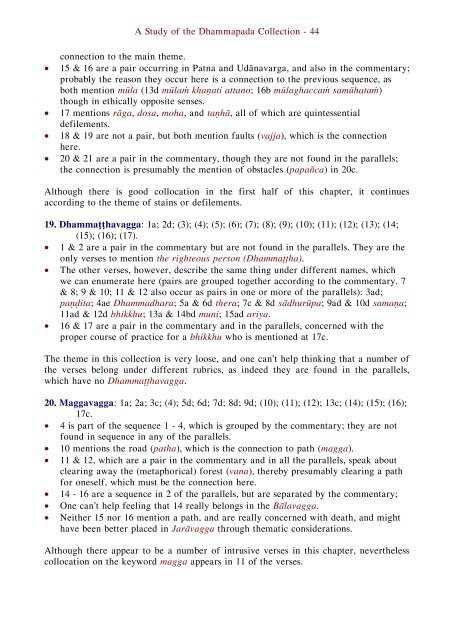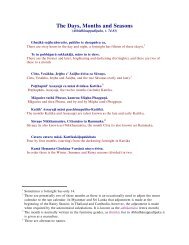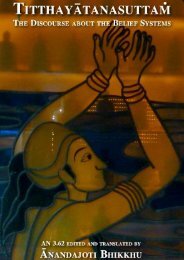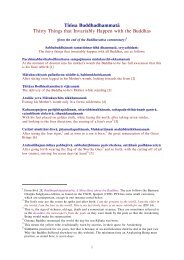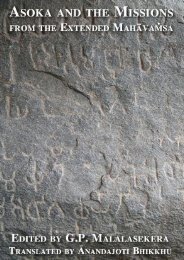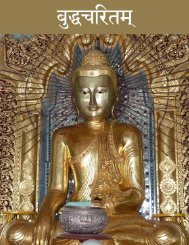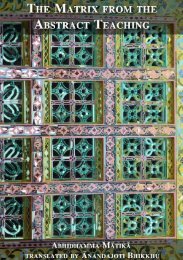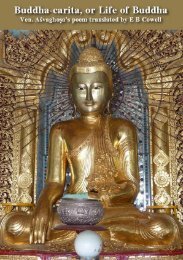The Comparative Dhammapada - Ancient Buddhist Texts
The Comparative Dhammapada - Ancient Buddhist Texts
The Comparative Dhammapada - Ancient Buddhist Texts
You also want an ePaper? Increase the reach of your titles
YUMPU automatically turns print PDFs into web optimized ePapers that Google loves.
A Study of the <strong>Dhammapada</strong> Collection - 44<br />
<br />
<br />
<br />
<br />
connection to the main theme.<br />
15 & 16 are a pair occurring in Patna and Udānavarga, and also in the commentary;<br />
probably the reason they occur here is a connection to the previous sequence, as<br />
both mention mūla (13d mūlaṁ khaṇati attano; 16b mūlaghaccaṁ samūhataṁ)<br />
though in ethically opposite senses.<br />
17 mentions rāga, dosa, moha, and taṇhā, all of which are quintessential<br />
defilements.<br />
18 & 19 are not a pair, but both mention faults (vajja), which is the connection<br />
here.<br />
20 & 21 are a pair in the commentary, though they are not found in the parallels;<br />
the connection is presumably the mention of obstacles (papañca) in 20c.<br />
Although there is good collocation in the first half of this chapter, it continues<br />
according to the theme of stains or defilements.<br />
19. Dhammaṭṭhavagga: 1a; 2d; (3); (4); (5); (6); (7); (8); (9); (10); (11); (12); (13); (14;<br />
(15); (16); (17).<br />
1 & 2 are a pair in the commentary but are not found in the parallels. <strong>The</strong>y are the<br />
only verses to mention the righteous person (Dhammaṭṭha).<br />
<strong>The</strong> other verses, however, describe the same thing under different names, which<br />
we can enumerate here (pairs are grouped together according to the commentary. 7<br />
& 8; 9 & 10; 11 & 12 also occur as pairs in one or more of the parallels): 3ad;<br />
paṇḍita; 4ae Dhammadhara; 5a & 6d thera; 7c & 8d sādhurūpa; 9ad & 10d samaṇa;<br />
11ad & 12d bhikkhu; 13a & 14bd muni; 15ad ariya.<br />
16 & 17 are a pair in the commentary and in the parallels, concerned with the<br />
proper course of practice for a bhikkhu who is mentioned at 17c.<br />
<strong>The</strong> theme in this collection is very loose, and one can’t help thinking that a number of<br />
the verses belong under different rubrics, as indeed they are found in the parallels,<br />
which have no Dhammaṭṭhavagga.<br />
20. Maggavagga: 1a; 2a; 3c; (4); 5d; 6d; 7d; 8d; 9d; (10); (11); (12); 13c; (14); (15); (16);<br />
17c.<br />
4 is part of the sequence 1 - 4, which is grouped by the commentary; they are not<br />
found in sequence in any of the parallels.<br />
10 mentions the road (patha), which is the connection to path (magga).<br />
11 & 12, which are a pair in the commentary and in all the parallels, speak about<br />
clearing away the (metaphorical) forest (vana), thereby presumably clearing a path<br />
for oneself, which must be the connection here.<br />
14 - 16 are a sequence in 2 of the parallels, but are separated by the commentary;<br />
One can’t help feeling that 14 really belongs in the Bālavagga.<br />
Neither 15 nor 16 mention a path, and are really concerned with death, and might<br />
have been better placed in Jarāvagga through thematic considerations.<br />
Although there appear to be a number of intrusive verses in this chapter, nevertheless<br />
collocation on the keyword magga appears in 11 of the verses.


